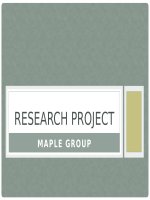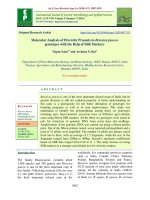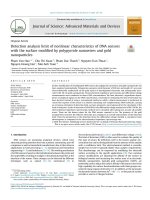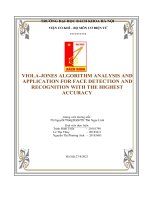Assignment 2 individual essay company analysis ikea establishes an organization named ingka foundation with the charitable purposes
Bạn đang xem bản rút gọn của tài liệu. Xem và tải ngay bản đầy đủ của tài liệu tại đây (475.45 KB, 15 trang )
BUSM 4692: Managing International
Business Responsibility
Assignment 2: Individual Essay - Company
Analysis
Subject Code:
Subject Name:
Location & Campus
Student Name:
Student Number:
Your Teacher:
Word Count:
1
Table of content:
A. INTRODUCTION:............................................................................................................................. 4
B. BACKGROUND OF IKEA COMPANY:........................................................................................... 4
C. ANALYSIS CSR PROGRAM:........................................................................................................... 5
1.
Stakeholder interests:.................................................................................................................... 5
2.
Environmental responsibility:..................................................................................................... 6
D. EVALUATION CSR PROGRAM:..................................................................................................... 7
1.
CSR’s literature review:............................................................................................................... 7
2.
The Success of CSR Programs:.................................................................................................... 7
3.
CSR’s program problems:.......................................................................................................... 10
E. RECOMMENDATIONS:................................................................................................................. 11
F.
CONCLUSION:................................................................................................................................ 11
G. REFERENCES:............................................................................................................................... 11
H.
APPENDIX:.................................................................................................................................. 14
2
I declare that in submitting all work for this assessment I have read, understood and
agree to the content and expectations of the Assessment declaration
A. INTRODUCTION:
In recent times, the global economy develops rapidly which relates to the increase in production and
commodity exchange. These influences lead to numerous serious consequences such as damage to
brand image and customer’s loyalty (Clark 2021). Thus, enterprises must find the appropriate solution
to solve these problems and corporate social responsibility is the proper activity for them to gain
different benefits from this method; for example, build brand image and consolidate consumer loyalty
(Murphy 2021). The company chosen to analyze in this essay is Ikea- one of the most famous furniture
company in the world which implements and reports their sustainability activities annually. In this
piece of paper, how CSR affects multinational company is analyzed coherently, especially Ikea. First of
all, a brief introduction of Ikea and the purposes of CSR program are identified. Then, CSR influences
on the operation of Ikea based on the information which related to CSR theories and gathered from
company report and sustainability report. A critical evaluation about the benefit of CSR for Ikea is also
provided based on the perspective of stakeholders like NGOs, union, and community. Last but not
least, some of the useful recommendations are investigated to support Ikea to improve their CSR
program.
B. BACKGROUND OF IKEA COMPANY:
According to Rud (2021), Ikea is the one of the largest furnishing retail companies in the world at the
present. The company was first founded in Sweden by Ingvar Kamprad in 1943 (Ikea Company n.d.).
Until now, Ikea has expanded to 50 markets with 422 stores and 139,000 employees in 2019 (Ikea
Company n.d.). The business aims to create the better living space for people through well-designed,
functional, and affordable furnishing products (Ikea Company n.d.). Regarding to Statista Research
Development (2021), Ikea maintains the stable retail performance for many years and gained 36
billion euros of the revenue in 2020. Besides developing financial performance, the organization also
concentrates on improving living conditions for citizens. Ikea’s founder - Kamprad said that the
company ensured to use a part of the profit to support the people in need. Ikea does the corporate
social responsibility for many years and CSR becomes one of its key values. To be specific, Ikea
establishes an organization named Ingka Foundation with the charitable purposes (Ingka Foundation
n.d.). Some of their dominant activities are recycling wastes into resources, protecting natural
resources, and using
3
reusable materials for their products (Ikea Company n.d.). Furthermore, Ikea also corporates
with UNICEF and supports educational programs for miserable children (Ikea Company n.d.).
The business started doing CSR from 2012 with the name People and Planet Positive and their
activities are reported particularly via company sustainability report (Dudovskiy 2019).
C. ANALYSIS CSR PROGRAM:
In this section, the CSR program of Ikea is analyzed completely based on the information
taken from Ikea Sustainability Report FY20.
1. Stakeholder interests:
a. Human rights and labor: Supporting human rights and providing safe workplace. The
international business has responsibilities to all stakeholders, especially their employees.
Respecting human rights is the important motivation for the employees and protects them
against discrimination in the workplace (National Action Plans on Business and Human
Rights n.d.). Furthermore, committing civil rights also contribute on recruiting potential
workers, attracting customers and investors (Amis 2011). After recognizing the importance of
it, Ikea are committed to respecting and supporting human right in its workplace.
To prove this point, the company ensures that the workplaces are safe, and the employee health are
always concerned. In FY20, the number of accidents in Ikea’s manufactory decreases 29% in
comparison with FY18 and the company constantly tries to reach the goal of zero accident in the near
future. Besides that, Ikea guarantees that the exertion of workers is admitted, and the salary is paid
equally based on the employee’s contribution. Ikea also promotes the equality of their workers,
prevents the discrimination between different religion and skin color.
b. Customers: encouraging people to live sustainable life.
First and foremost, Ikea strongly supports its customers to live the more sustainable life. According to
the details in company sustainability report FY20, more than 40% of their customers live in the high
water-stressed areas. Thus, the firm produces water-recycling shower to solve this problem. This
method saves 80% of water and 70% of energy for their clients’
4
home. Additionally, Ikea supplies 10,000 solar panels to customer’s home that estimates to
save EUR 10 million and 60,000 tons of . The life of products is also prolonged to promote
customers pass on products in circular ways.
c. Community: supporting communities during Covid-19 pandemic.
The year 2020 is very special due to the serious situation of Corona pandemic which relates
to the difficulties for many people. Because of that, Ikea creates many policies with the aim
to support citizens overcome this challenge time. As stated in Ikea sustainability report
FY20, this enterprise donates 1.7 million products for epidemic prevention, for example,
face masks, beds, foods and health centers and hospitals. In India, Ikea store helps 200 beds
with numerous of necessities like pillows, pillow covers and water bottles. Moreover, Ikea
China supported 117,000 medical equipment for hospitals and Ikea Spain donated 5,000
hospital beds. To improve the quality of home learning, the business also corporates with 80
charities to provide “let’s play and learn” kits to 10,000 vulnerable children.
2. Environmental responsibility:
a. Transforming into a circular business:
The most concentrated environmental goal of Ikea is transforming into a circular business.
Circular business model is defined as the way that a company creates, captures, and delivers
value with the logical solution to improve resource efficiency and contribute to the extension
of products life (Nußholz 2017). Ikea sets the goal to design 100% of products be reused,
refurbished, recycled, and remanufactured at the beginning. To achieve this point, the firm
carefully selects and combines materials to produce the products that designed with the
standardization and adaptability enable reuse and refurbishment via maintenance and repair.
In addition, Ikea decides to use only renewable or recycled materials for their products. For
instance, 60% of Ikea products are made from renewable materials and 10% of them produced
from recycled materials. There are four circular loops within the firm’s circular model
(Appendix 1).
b. Becoming climate positive:
By 2030, Ikea committed to greenhouse gas emission within its business operation and becomes
climate positive. The company investigates some solutions such as attempting towards 100% of
5
renewable energy, promoting sustainable resources and materials, changing into circular business. Ikea
creates number of targets improve their footprint on climate such as drastically decreasing greenhouse
gas emission, storing carbon in land or products and extending the project beyond the company by
motivating customers using renewable resources at their house. In 2020, the carbon footprint produced
by Ikea is approximate 21.2 million tones and reduces 11% compared to the previous year (Appendix
2). In general, Ikea achieves significant success of becoming climate positive in a few years and it
continue to develop this goal until 2030.
D. EVALUATION CSR PROGRAM:
1. CSR’s literature review:
Although the topic of Corporate Social Responsibility has been discussed since 1950, the
precise definition for CSR is still unknown (Thacker 2019). Normally, CSR refers to a firm’s
activities that combine the concerns of society, environment, and ethics with the business
operation to create value for its shareholders and stakeholders (Newman et al 2020). Apart
from evaluating CSR program through company report, people can estimate the CSR program
through the company’s performance in reality and the perspectives of its stakeholders
(Dongho & Jieun 2018). In the situation of Ikea furnishing company, there are two concepts
chosen to evaluate the CSR program. The first theory is Carroll’s Pyramid that focuses on 4
perspectives of CSR and Stakeholder theory.
2. The Success of CSR Program s:
a. The Carroll’s Pyramid:
Pyramid of Corporate Social Responsibility refers to the requirements, expectations, and
desires of numerous stakeholders that a business must satisfy to meet its CSR. It was created
by Archie Carroll and includes four main responsibilities of the organization which are the
responsibility of economy, legality, ethic, and philanthropy (Bhasin 2019). In this essay, the
Carroll’s Pyramid is applied to evaluate Ikea’s CSR program.
6
Figure 1: Pyramid of Corporate Social Responsibility (Source: Carroll 1991)
Economic responsibilities are the most basic requirements of every company and the foundation for
other requirements; thus, it was listed at the bottom of the CSR Pyramid. The responsibility involves
maximize the revenue, commit to be profitable, maintain the competitive position and operate
efficiently (Carroll 1991). In spite of the serious circumstance of COVID 19 pandemic, Ikea achieved
the strong financial performance in FY20. The value of sales of goods in 2020 is EUR 22,387 million
and the total revenue is approximate EUR 23,613 million (Ikea Company 2021). In 2017, although the
pandemic does not occur, Ikea’s financial results are not successful as FY20. The total revenue of FY17
is about EUR 22,878 million which is less than 2020 EUR 1,226 million (Appendix 3&4). In general,
Ikea is developing remarkably from year to year and achieves the impressive financial results despite of
the hard period. Owing to the strong increase in finance, Ikea has enough ability to improve the
working condition for their employees and satisfy their shareholders’ interests (Shuwaler et at 2020).
The second responsibility of businesses to meet their CSR is Legal responsibilities. Aside from
focusing on generating profits, firms are required to obey the laws and regulations promulgated by
local governments (Tamvada 2020). A successful business is known as the one that
7
accomplishes its legal obligations and complies with the rules of federals, states, and local
governments (Carroll 1991). Although there are some problems relating to legality, Ikea are trying
to improve these issues day-by-day. As stated in Ikea Sustainability Report FY20, Ikea faced
numerous charges due to the illegal wood sources from Ukrainian suppliers. Hence, the firm and
the Wood Supply and Forestry specialist team implemented an investigation and confirmed that
there is no illegal logging in their supply chain. Besides that, the company also corporates with its
partner that is Worldwide Funds for Nature (WWF) to decrease the illegal logging and protect oldgrowth forests (Ikea Company 2021).
Thirdly, Ethical responsibilities are the one expected by number of company’s stakeholders
(Wong & Dhanesh 2017). An organization embraces ethical responsibilities when it equally
treats all stakeholders which consist of employees, investors, suppliers, and customers
(Stobierski 2021). Ikea always provides the most comfortable working conditions for
employees and adjusts its products and services to satisfy customers interests. Besides that, the
benefit of supplier is also one of their concerns. During FY20, the key goal of Ikea is
developing healthcare and safety for their employees. Moreover, equality between colleagues
is also one of their core values and cultures (Ikea Company 2021). Besides that, during Covid19 pandemic, Ikea communicates with its suppliers to understand what they need to do
together. The enterprise also follows the purchase agreements if it is possible and adjust in
order not to cancel any future orders (Ikea Company 2021).
The ultimate responsibility of business to achieve CSR is Philanthropic responsibilities. Regarding to
Kurniawati & Danthy (1991), Philanthropic responsibilities refer to the communities’ expectation of
the firms which relates to chariable actions. Generally, these activities are understood as the voluntary
activities that an enterprise contributes its available resources to support education or improve citizen’s
living conditions (Grigore 2010). However, in contrast with Ethical responisbility, unless the company
achieve Philanthropic responsibilities, it does not mean that this is the unethical business (Carroll
1991). To achieve this point, Ikea founded an charitable organsisation named Ingka Group to support
the community and environment for many years. Ikea donates a large amount of its availble resources
to support the community for a long time, especially during this difficult period. For instance, Ikea
Canada commited to donate approxiamte $2 million for the local society to overcome this time (Ikea
8
Canada 2020). Besides that, Ikea also takes responsibility for the environment. To
demonstrate this point, Ikea invested $220 million for green energy, reforestation and project
of forest protection in 2019 (Cuff 2019). In brief, Philanthropic responsibility is one of the
most important concerns of Ikea and the enterprise strives for fulfilling this responsibility.
b. Stakeholder theory:
According to Freeman (1984), Stakeholder is understood as the parties that either affect or be
affected by the company operation. These people includes employees, customers, suppliers,
governments and shareholders. In order to become a successful business, not only does the
firm simply generate profits, but it also satisfies the stakeholder’s interests equally (Dooms
2019). Ikea makes an effort to cover all stakeholders demands from the most important
stakeholders like customers, employees, or suppliers to the community. The benefits of
stakeholders are the important concerns of Ikea for many years (Fernando 2021). To
demonstrate this attempt, Ikea facilitates its employees the most comfortable working
conditions as mentioned in the section above. In 2020, Ikea Canada has donated $500,000 and
products to help community overcome this period. This fund is used to support many different
organisations like Black Health Alliance, Save the Children and National Association of
Friendship Centers (Ikea Company 2020). Overall, Ikea spends lots of available resources to
satisfy its stakeholders interests, especially during Covid 19 pandemic.
3. CSR’s program problems:
As mentioning in the part of the evaluation CSR, Ikea has meet its CSR based on Pyramid of
CSR and Stakeholder Theory: Normative Perspective. However, there are some problems
occur during the operation that need improving as soon as possible.
a. Using political prisoners as forced labors:
The Sweden furnishing company received numourous critizism from society since using political
prisoners as its forced labour since three decades ago (Milmo 2012). Ikea published an independent
report and admitted that it allowed political prisoners to engage in manufacturing products in East
German 25 or 30 years ago (SBS News 2012). Hence, Mr. Wagner, the chairman of victim’s group
UOKG expected that Ikea would pay a fair compensation for these victims.
b. Selling products related to illegal resources:
9
According to a non-profit environmental organization, Ikea is doubted to use illegal logging
from Russia for their products which threatens the natural environment and impacts negatively
on the climates (Lehren et al. 2021). To be specific, some of the Ikea’s most popular children’s
furnishing goods like Sundvik beds and Flisat Dollhouse made from pine wood which
supplied by a Russian logging company in Seberia. However, these wood is cut illegally from
protected forest and raised serious argument for Ikea (Lehren et al. 2021).
E. RECOMMENDATIONS:
a. Regulating HR management and compensation of employees:
Human resources management must fulfill the safety and healthcare of labors and obey the
relevant laws of the local government. Ikea made the serious issue in HR managemt, thus
the firm has to adjust their CSR relating to human right and compensate rationally for these
victims (Odina n.d.).
b. Managing supply chains carefully:
Ikea always maintains a good relationship with their suppliers and supports them to develop,
especially during Covid 19 pandemic. Nevertheless, this is also the chance for them to exploit
the confidence of the business and make some mistakes that directly affect the reputation of
Ikea. Hence, it is important to manage the sources of supply carefully to avoid thesr problems
(Nicasio 2021).
F. CONCLUSION:
Corporate Social Responsibility plays an important role in the long-term achievement of a company.
In this paper, Ikea’s CSR program was analysed and evaluated completely based on Stakeholder
theory and Carroll’s Pyramid of CSR. In general, the company achieves its CSR with many
sustainable activities and satisfies the interests of stakeholders. However, Ikea meets some mistakes
that partly influence on its reputation. For this reason, Ikea should constantly adjust their CSR
program to improve the problems and develop company in long-term.
G. REFERENCES:
Amis, L 2011, ‘A Guide for Business How to Develop a Human Rights’, The Global
Compact, viewed 23 August 2021, <develophumanrightspolicy_en.pdf>
10
Bhasin, H 2019, ‘What is Carroll’s Pyramid of Corporate Social Responsibility?’, Marketing
91, viewed 25 August 2021, < />Carroll, A.B 1991, ‘The Pyramid of Corporate Social Responsibiiity: Toward the Morai
Management of Organizational Stakeholder’, Business Horizons, Vol. 34(4), pp. 39-48
Clark M, 2021, ’11 Organizations with Negative Brand Image and How They Overcame It’,
Etactics, viewed 9 August 2021, < />Cuff, M 2019, ‘IKEA to invest $220 million into becoming 'climate positive', GreenBiz,
viewed
26
August
2021,
< />
becoming-climate-positive>.
Dongho, Y & Jieun, L 2018, ‘The Effects of Corporate Social Responsibility (CSR) Fit and CSR
Consistency on Company Evaluation: The Role of CSR Support’, Sustainability, vol. 10, iss.8.
Dooms, M 2019, ‘Stakeholder Management for Port Sustainability’, Science Direct, viewed 26
August 2021, < />
Dudovskiy, J 2019, ‘IKEA Corporate Social Responsibility (IKEA CSR): a brief
overview’, Business Research Methodology, viewed 19 August 2021, < />Grigor, G 2010, ‘Ethical and Philanthropy Responsibilities in Practice’, Annals of the
University of Petrosian, Economics, vol. 10 (3), p. 167-174.
/>Ikea Canada 2020, ‘IKEA Canada commits over $2M to support local communities impacted
by COVID-19’, Cision, viewed 26 August 2021, < />Ikea Company 2018, ‘Ikea Sustainability Report FY17’, Company Report, Ikea
Company, viewed 24 August 2021.
11
Ikea Company 2020, ‘IKEA Canada donates $500,000 as part of its ongoing COVID-19
community relief’, Ikea Company, viewed 26 August 2021, < />Ikea Company 2021, ‘Ikea Sustainability Report FY20’, Company Report, Ikea
Company, viewed 24 August 2021.
Ikea Company n.d., ‘Reaching more of the many people’, Ikea Company, viewed 19
August 2021, < />Ikea Company n.d.,’ Vision, Culture and Values’, Ikea Company, viewed 19 August
2021, < />Ingka Foundation n.d., ‘Welcome to Ingka Foundation’, Ingka Foundation, viewed 19
August 2021, < />Kurniawati, C & Danthy, M 2018, ‘The Impacts of Philanthropy Responsibility and
Ethical Responsibility Toward Customer Purchase Behavior and Customer Loyalty’,
Journal of Management and Marketing Services, vol.10 (1), p. 95-116.
Milmo, C 2012, ‘Ikea used forced prison labour to make furniture’, Independent, viewed
27 August 2021, < />Murphy, C.B. 2021, ‘Why Social Responsibility Matters to Business?’, Investopedia,
viewed 9 August 2021, < />National Action Plans on Business and Human Rights n.d., ‘Worker’s right’, National
Action Plans on Business and Human Rights, viewed 23 August 2021,
< />Newman, C, Rand, J, Tarp, F & Trifcovic, N 2018, ‘Corporate Social Responsibility in a
Competitive Business Environment’, The Journal of Development Studies, vol. 56, pp.
1455-1472.
12
Nicasio, F 2021, ‘10 Supply Chain Management Best Practices for Retailers’, Vend
by Lightspeed, viewed 26 August 2021, < />Nußholz, J.L.K 2017, ‘Circular Business Models: Defining a Concept and Framing
an Emerging Research Field’, MDPI, viewed 25 August 2021
Odina n.d., ‘Legal Regulatory Requirements on the Human Resource Process’, Chron, viewed
27 August 2021, < />SBS News 2012, ‘Ikea regrets use of forced prison labour’, SBS News, viewed 27 August
2021, < />Shuwaler, A.A, Quttainah, M.A, Kee, A.Q & Kei, C.M 2020, ‘IKEA’s Corporate Social
Responsibility’, International Journal of Tourism & Hospitality in Asia Pacific.
Statista Research Development 2021, ‘Net income of INGKA Group (Ikea) worldwide from
2009 to 2020’, Statista, viewed 19 August 2021,
< />Stobierskiy, T 2021, ‘Types of Corporate Social Responsibility To Be Aware Of’, Harvard
Business School Online, viewed 26 August 2021, < />Tamvada, M 2020, ‘Corporate social responsibility and accountability: a new theoretical foundation
for regulating CSR’, International Journal of Corporate Social Responsibility, no. 2.
Thacker, H 2019, ‘Understanding the four levels of CSR’, The CSR Journal, viewed 24
August 2021, < />Wong, J.Y & Dhanesh, G.S 2017, ‘Corporate social responsibility (CSR) for ethical
corporate identity management’, Corporate Communications, Vol. 22, Iss. 4.
H. APPENDIX:
13
Appendix 1: Four circular loops within the firm’s circular model
Appendix 2: The climate footprint per euro (Retail sales)
14
Appendix 3: Consolidated income statement
FY17 of Ikea
15









